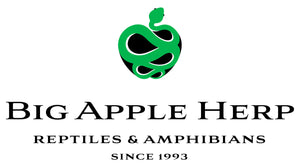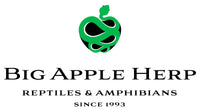Care Sheet For King Snakes
King Snakes include some of the most beautiful subspecies of any genus and they are easy to keep in captivity which explains why they are incredibly popular with reptile hobbyists. The genus of King Snakes contains an incredible variety of snakes that have a large range of sizes and habitats. King Snakes come from grasslands, farmlands, pine and deciduous forests, deserts and even swamplands. They generally reach adult sizes anywhere from 2 to 6 feet. For these reasons, it is difficult to provide a single care sheet for all species and subspecies of King Snakes, but below is a basic outline of how to keep your King Snake happy and healthy. At Big Apple Pet Supply, we carry only Captive Bred King Snakes to maintain strict quality control.
Housing
Baby and juvenile King Snakes can be set up in an enclosure as small as a 10 gallon (20" x 10" x 12"H) but adults should be housed in a larger enclosure of 20 to 70 gallons (36" x 18" x 25"H) depending on their full adult size to allow for additional room and a better design. For example, a subspecies that becomes a 4 foot adult should be housed in an enclosure at least 40 gallons in size. There is no such thing as a cage too big for a King Snake so larger is always much better than smaller. Since like most snakes, King Snakes are escape artists, a secure screen top is absolutely critical to keep your snake from escaping the enclosure.
You should NEVER house more than one King Snake together as King Snakes sometimes are cannibalistic.
Substrate
Zoo Med Aspen Snake Bedding is generally the best substrate for King Snakes. Reptile keepers also use Zoo Med Repti Bark, Zoo Med Forest Floor Cypress Bedding or Zoo Med Eco Earth. Baby King Snakes can also be kept on paper towels or similar product until they become juveniles. Whichever you decide to use, stick to well-known products designed for use with reptiles and be careful of some commercial aspen brands as they may contain high amounts of dust or other contaminants that can be harmful to your pet.
Heating
As with all reptiles, King Snakes need a thermal gradient consisting of a warm side (86° F) and a cool side (78° F). The best way to heat your King Snake’s enclosure is with a combination of heat mat and ceramic heat emitter. We recommend the Intellitemp Heat Mat and Big Apple Black Heat Infrared Ceramic Heat Emitter. The heat mat and ceramic heat emitter should be on one side while the other side should not have any heat source. We recommend controlling the ceramic emitter with a thermostat, such as the BAH-500 or BAH-1000DC, and monitoring the temperatures with a thermometer.
Lighting
King Snakes, like all snakes do not require a light or UV bulb. If you choose to add a basking bulb to add more light to your cage make sure that you maintain proper heat levels but not go over 88 deg. F as this could be detrimental to your snake's health.
Shelter
It is essential to the well-being of your King Snakes to have hiding places in their enclosure. The shelter can be anything from a Big Apple Basic Reptile Hide Box to a decorative reptile shelter, hiding hut or cave. It is always a good idea to have one shelter on the warm side and one on the cool side. If you choose to make a hiding place yourself, please make sure it is sturdy enough that there is no potential for collapsing and crushing your snake.
Shedding
Like all reptiles and amphibians, King Snakes shed their entire skin all at once. Babies shed more often than adults because as babies they outgrow their skin faster. You'll note shedding time when your snake's eyes turn a shade of blue and become cloudy.
Snakes normally shed their skin easily but sometimes they have issues if they do not have the proper humidity while shedding. For this reason, it is important to maintain a decent amount of humidity in the cage by misting a couple times a day. This is especially true around shedding time. Providing a moist shelter is another way to ensure necessary humidity during shedding. Use moistened Big Apple Imported Premium Grade Sphagnum Moss or Zoo Med Forest Floor Cypress inside your snake’s hide.
You need to check your snake after it has shed to make sure it was able to peel all the skin off, especially around the eyes. If unshed skin is not removed promptly serious health issues can form. If your King Snake has retained skin after shedding you can place the snake in a plastic container lined with warm, wet paper towels with the container lid on or soak the snake in warm water. Let the snake stay in the container or warm water for approximately 30 minutes. The high humidity in the container or using the soaking method should loosen the skin enough to allow you to remove it easily with a pair of tweezers. If the skin has not loosened enough, reheat the paper towels with warm water and provide another 30 minute session. NEVER use hot water as this can burn your snake.
Water
It is essential that you provide your King Snake with a large water bowl. The bowl should be large enough that the King Snake can soak its entire body but not so big that it might have a difficult time getting in or out of the bowl. Place the water dish on the cool side of the cage so that it does not evaporate quickly.
Food
King Snakes eat mice and rats so the size of the prey is dependent upon the girth of the snake. You should not feed your King Snake anything bigger than the thickest part of its body. The prey item should leave a readily noticeable lump in the snake. This is fairly standard for all species of snakes. Hatchling snakes are typically fed every 5 days while adults are typically fed every 10 days. However, it should be noted that some hobbyists feed adult snakes once a week.
Feeding live or pre-killed is a question we are often asked. Opinions vary on this subject but we are emphatic that thawed frozen rodents are a much better option. First, feeding thawed rodents is easier and second it's substantially less expensive because you can purchase rats or mice in bulk and then store them in the freezer. More importantly, it is significantly safer for the snake. The bottom line is a thawed prey mouse or rat will never bite or chew on your snake in defense. We have seen nasty rodent bites inflicted on snakes when fed live rodents. We suggest you play it smart and go with feeding thawed prey items. At Big Apple Pet Supply, we carry a huge selection of frozen feeders that we deliver right to your door.
Vitamins
It is important to feed high quality rodents to your snake and it is always a good idea to coat the rodent with a bit of vitamin and calcium powders before feeding them. We carry a full line of quality reptile vitamins and calcium.
Cage Maintenance
King Snakes require minimal maintenance as they usually excrete small amounts of semi-solid fluid. Aspen and similar substrates allow for quick cleaning of feces using one of our scoopers. The bedding should be completely thrown out and the entire cage (including all accessories) should be washed at least once every four to five months with Quat TB Pet Area Cleaner, Deodorizer & Stain Remover or a mild detergent. If using paper towels, change all paper towels at least once a week.
Hibernation
Hibernation while being natural for King Snakes in the wild is not necessary for pet King Snakes. We believe you should heat your King Snakes throughout the winter so that they continue to eat, drink and be active. A general reduction in feeding behavior is normal during winter months due to temperature fluctuations in your house. As long as they keep fairly consistent weight it is generally not an issue and normal feeding typically resume in the spring.


